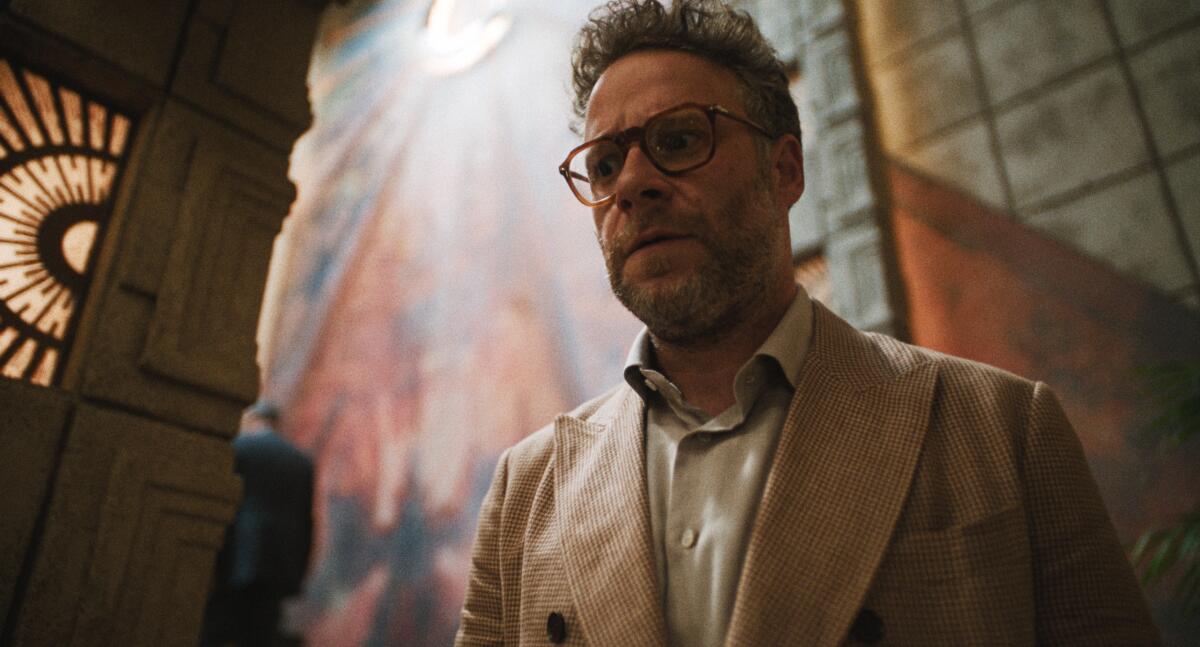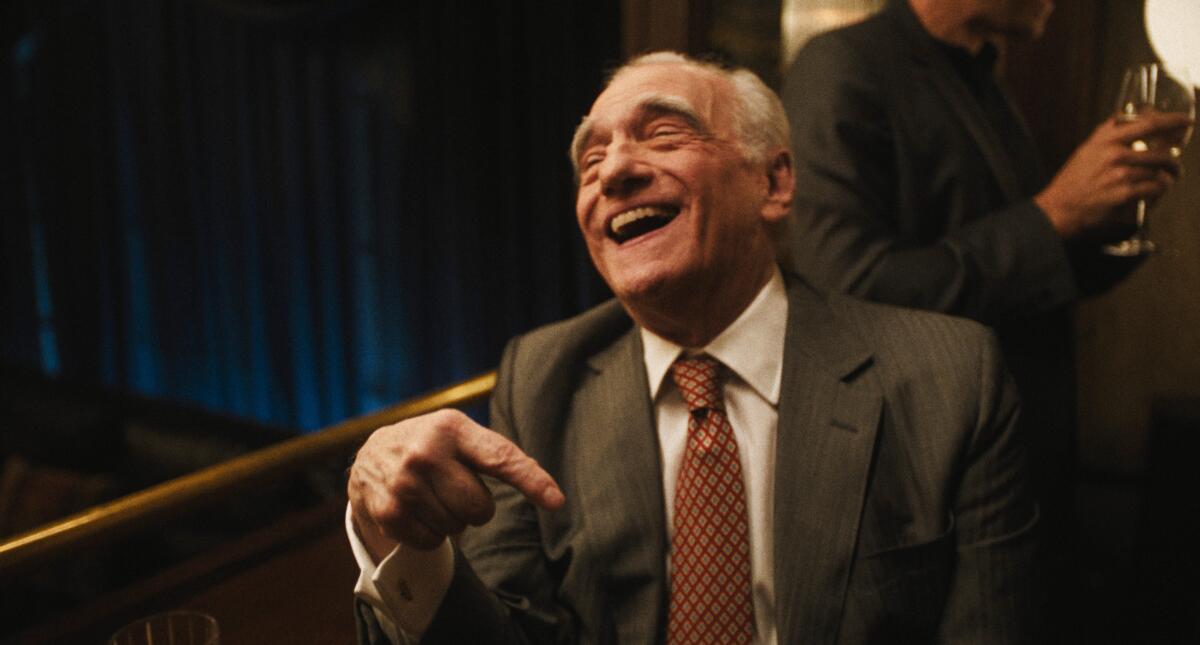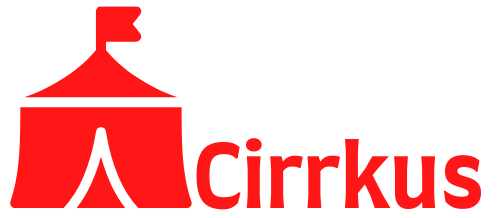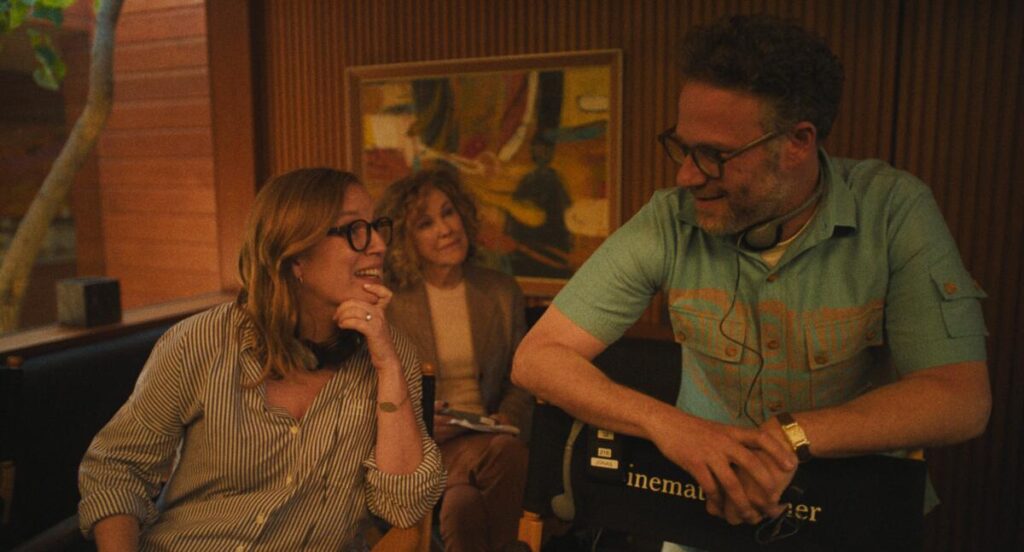For his episode of “The Studio,” Ron Howard really wanted to do his best.
The director of “A Beautiful Mind” — a former child star — was playing himself in Apple TV+’s Hollywood comedy, created by Seth Rogen and Evan Goldberg, about a beleaguered executive portrayed by Rogen. But this Ron Howard was an alternate universe version of Ron Howard, who instead of being notoriously nice, is sort of a jerk.
“He was very determined to deliver a good performance,” Goldberg remembers. “He had not acted in this manner in a very long time. He took some lessons. He really put his best foot forward.”
Rogen adds: “We would rehearse over Zoom; he wanted to read the scenes a bunch of times.”
Howard even suggested movies of his they could make fun of in the script.
The Academy Award winner (and “Happy Days” star) is one of many celebrities that guest star over the course of the inaugural season of “The Studio.” Each half hour tackles a different headache for Rogen’s Matt Remick and with it comes a meaty role for a director or actor to skewer his or herself. In addition to Howard, “The Studio” also features Martin Scorsese, Charlize Theron, Nicholas Stoller, Sarah Polley, Greta Lee and Anthony Mackie. And that’s just in the first three episodes — the latest is now streaming. Later, Zoë Kravitz, Dave Franco, Zac Efron, Olivia Wilde and Ramy Youssef show up — just to name a few. So why all the famous faces parodying themselves?
Sarah Polley, left, with Catherine O’Hara and Seth Rogen. The filmmaker appears as herself in Episode 2, “The Oner.”
(Apple)
“We honestly just kept saying we didn’t want to do something that was some fantastical version, we wanted it to be as reflective of reality as possible,” Goldberg says. “That was our North Star: What is the reality of our lives and the people who work in Hollywood?”
Rogen and Goldberg created the series alongside Peter Huyck, Alex Gregory and Frida Perez. And while Perez is a relative newcomer, Huyck and Gregory both wrote on a series that served as inspiration for the way “The Studio” would handle guest appearances: “The Larry Sanders Show,” starring Garry Shandling as the eponymous talk show host who would interview real celebs on his fake show.
“The main thing we all connected on was ‘The Larry Sanders Show,’ ” Huyck says, recalling his initial conversation with Goldberg and Rogen. “That was the common tie, and they were like, ‘We’ve been spending a lot of the pandemic watching it, you guys wrote on it. Would you want to create a show with us similarly using celebrities to play versions of themselves but telling a new chapter and more personal version that really speaks to where the four of us were at that time?’ ”
The version they dreamed up — alongside Perez — was a series that uses each episode to tackle a different Hollywood mini-issue through the eyes of the perpetually stressed Matt. They came across some of the themes thanks to research meetings they had with execs before they started writing.
“We heard a story about an executive who is terrified to give a director a note, so that’s an episode,” Gregory says. Another executive told the writers that he or she would cry the entire limo ride home if the talent didn’t offer thanks during an award show speech. That comes up later in the season when Matt attends the Golden Globes.
Matching the guest star to the scenario was a meticulous exercise.
Take for instance, Howard. In the episode, “The Note,” Matt has to tell a famous director that the last act of his movie just doesn’t work. Rogen and Goldberg wanted someone who was famously good natured so they could subvert that reputation, as well as someone who had both prestige and box office hits, which meant they were hard to criticize from an executive’s standpoint. They also needed a person who made a movie with a twist ending around the time Matt would have started working in Hollywood. On screen, Matt is living with the trauma of having told Howard years ago that it was a bad idea to save the revelation that Paul Bettany’s character isn’t real for the end of “A Beautiful Mind.”

Seth Rogen plays Matt Remick, an anxious studio executive leading the fictional Continental Studios. “We heard a story about an executive who is terrified to give a director a note, so that’s an episode,” Alex Gregory says.
(Apple)
“The Venn diagram of what we were looking for and who exists was literally Ron Howard,” Rogen says.
The requirements for the various roles were so specific that if the creators couldn’t get the star they had written the material for, they would just write a new episode.
“There was a test screening episode that literally like two or three people on Earth fit the bill for who it could be and they were all unavailable,” Rogen says.
The material might still see the light of day: Should they get a second season, they’ll revisit. The people who would be right for the job were willing to do it, they just couldn’t make the timing work.
Meanwhile, Goldberg and Rogen would always leave room for the guest star to shape his or her character during a pre-shoot discussion. Polley, for instance, added more motivation for her character. Without giving too much away, in a later episode Kravitz, “had very specific thoughts about her knowledge of drugs would be, what her experience would be, what seemed believable in that capacity,” Rogen says. Howard meanwhile had suggestions when it came to the ways other characters might suck up to him.
“We were like, ‘Oh we want some people to say some sycophantic stuff to you,’ ” Goldberg remembers. “He was like, ‘Five incredibly sycophantic things that have been said to me in my career.’ ”
While Rogen and Goldberg had preexisting relationships with some of the stars who did come to set, many of them were not people they were close to or knew at all. That helped given that Rogen and Goldberg were directing every episode.
“It’s kind of easier when we don’t know them, to be honest,” Goldberg says. “They’re not as comfortable telling us what to do.”
In fact, Scorsese, who guests in the very first installment, even held his tongue when he noticed that the pair was doing something wrong. “I wish he’d interrupted us and be like, ‘Do it this way, boys,’ ” Goldberg adds.
Scorsese established the level of talent they were hoping to get right out of the gate. Over the course of the plot, Matt, a cinephile, convinces the “Goodfellas” director to helm a movie based on Kool-Aid — except in Scorsese’s version, the brand is just a way to talk about the Jonestown massacre. When it turns out that Matt’s boss (Bryan Cranston) won’t stand for that, Matt has to fire the revered filmmaker.

“I wish he’d interrupted us and be like, ‘Do it this way, boys,’ ” says Evan Goldberg about working with Martin Scorsese, who made a cameo in the first episode.
(Apple)
“Narratively, his existence just ups the stakes of everything, which is why we wanted him,” Perez says. “Getting Martin Scorsese to do the Kool-Aid movie would be the happiest day of your life, objectively, and then firing him would be the worst day of your life. But you wouldn’t feel that about everybody.”
Rogen and Goldberg didn’t meet Scorsese before filming. “I honestly was afraid he just wasn’t going to show up,” Rogen says.
When he did arrive, they found he was a surprisingly good improviser.
“He was so funny,” Rogen says. “Like, I’ve been on ‘Curb Your Enthusiasm’ and improvised with Larry David and some of the greatest comedic improvisers that are walking the Earth. I’ve been very fortunate to work with some of the best and he legitimately was as funny and quick as any person I’ve ever improvised with on camera before.”
Goldberg and Rogen do have a wishlist of people who they hope will show up in future seasons, and Rogen was confident enough to put one dream on the record: Vin Diesel. “I am trying to say it publicly to make sure he sees it,” Rogen says with his trademark chortle. “I want Vin Diesel more than anyone.”
Why?
“He’s great. I love him, and he fills such a specific role in the industry. It would be fun also to see him not in a ‘Fast and Furious’ movie.”
Content shared from www.latimes.com.

